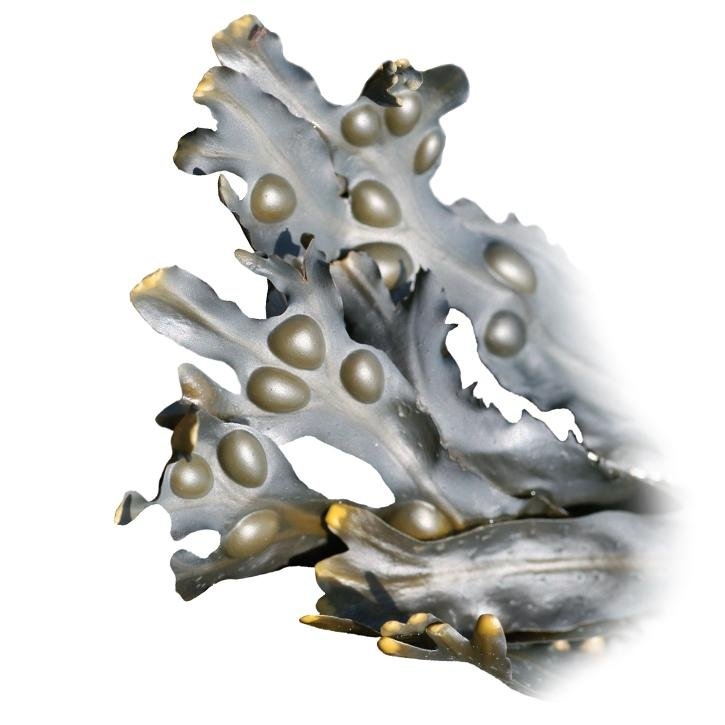Description
Bladderwrack (bladderwrack or bladderwrack) is a marine alga found in the Atlantic and Pacific oceans, as well as on the coasts of the North Sea and the Baltic Sea. It has characteristic vesicles, filled with nitrogen gas, which are arranged in pairs on both sides of the midrib. It can reach up to 1 meter in length.
Part used
The thallus is used.
Main constituents
- Mucilaginous polysaccharides: algin (18-30%), fucoidan, laminaran or laminarin.
- Abundant mineral salts (13-23%) among which iodine stands out in the form of inorganic salts and bound to proteins and lipids.
- Vitamins: B1, C, E and small amounts of B12; beta-carotene and zeaxanthin.
- Fucoxanthin: carotenoid of the xanthophylls family that gives these algae their greenish-brown color.
- Other components: mannitol, sterols (fucosterol), and polyphenols.
Pharmacological activity
- Satiating: due to its polysaccharide content, especially alginates.
- Thyroid stimulant and activator of basal metabolism: due to its iodine content.
- Delays the absorption of glucose and lipids.
- Mechanical laxative: due to its polysaccharide content.
- Diuretic: due to its mineral salts content.
- Remineralizing: due to its high mineral salt content.
- Thermogenic: fucoxanthin induces the expression of UCP1 in the mitochondria of white adipose tissue adipocytes, causing them to behave like those of brown adipose tissue (increasing fatty acid oxidation and heat production). This effect may be useful in weight control treatments.
- Fucoidan has shown "in vitro" an inhibitory effect on Helicobacter pylori growth, in addition to inducing an increase in the thickness of the gastric mucous layer and inducing apoptosis in different cancer cell lines. Its potential usefulness in the treatment of chronic gastritis, peptic ulcers and gastric and colorectal cancers is advocated.
Indications
Coadjuvant in the treatment of obesity, overweight, cellulitis.
Contraindications
- Pregnancy and lactation.
- Thyroid diseases.
- Cardiac diseases.
- Nervousness, insomnia.
Precautions
- Diabetics: it is recommended to control blood glucose.
- The EMA establishes that the daily limit of 400 μg of total iodine per day should not be exceeded.
- The Scientific Committee on Food (SCF) established an upper limit for iodine intake of 600 μg/day for adults and 200 μg/day for children aged 1 to 3 years.
Drug interactions
- Thyroid hormones or antithyroid agents.
- Due to its mucilage content it may interfere with the absorption of other drugs when taken concomitantly so it is recommended to distance the intake of both at least one hour.
Side effects
In particularly sensitive people or at high doses and/or prolonged treatments, it may alter thyroid function.
Bibliography
Monografía de la SEFIT (Sociedad Española de Fitoterapia).
Manual de Fitoterapia. Encarna Castillo García e Isabel Martínez Solís. 2ª edición Elsevier.
Catarino MD, Silva AMS, Cardoso SM. Phycochemical constituents and biological activities of Fucus spp. Mar Drugs. 2018; 16(8). pii: E249. doi: 10.3390/md16080249.
Wan-Loy C, Siew-Moi P. Marine algae as a potential source for anti-obesity agents. Mar Drugs. 2016; 14 (12). pii: E222.
Shoketsu Hitoe, Hiroshi Shimoda. Seaweed fucoxanthin supplementation improves obesity parameters in mildly obese Japanese subjects. Functional Foods in Health and Disease 2017; 7(4): 246-262.
Hui Zhang, Yibo Tang, Ying Zhang, et al. Fucoxanthin: a promising medicinal and nutritional ingredient. Evid Based Complement Alternat Med. 2015; 2015: 723515.
Maria Alessandra Gammone and Nicolantonio D’Orazio. Anti-obesity activity of the marine carotenoid fucoxanthin. Mar. Drugs 2015, 13, 2196-2214.
